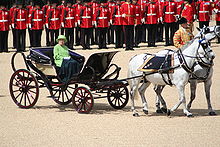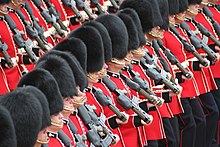Trooping the Color


Trooping the Color ( German : " Show the colors of the flag to the troops") is the annual military parade in June in honor of the birthday of the respective British monarch .
The parade usually takes place on the second Saturday in June at Horse Guards Parade , the largest open square in London , and is carried out by soldiers from the Household Division , which brings together all of the British infantry and cavalry regiments with Garderang . It is taken from the monarch, who is accompanied by other members of the royal family . Numerous national and international guests of honor as well as a large public audience take part.
history
The origin of the ceremony lies in the custom of showing the troop flags daily in front of the soldiers so that they could see them and recognize them later in battle. This close connection to the flag was necessary in order to have a fixed point of orientation in the chaos of historical battlefields, which - without modern means of communication - made it possible to lead the troops and their location on the battlefield in the first place. Trooping the Color , which was carried out for the first time under Charles II of England, transferred this symbolism to the person of the monarch: displaying the flags in front of the guards regiments in the presence of the ruler was intended to remind them of their special duty to him. The ceremony has been publicly held since 1805 and has taken place annually since then - with a few exceptions such as in the years of World War II , in 1948 because of unusually bad weather, in 1955 because of a railway strike and in 2020 because of the corona pandemic . The monarch actually does the parade on horseback; Due to the advanced age of Queen Elizabeth II, however, she now uses a carriage and a small grandstand on the parade ground.
procedure

Before the start of the parade, the units taking part in the Horse Guards Parade line up in L formation, with the combined music corps of the guards regiments and the infantry units competing directly on the parade ground and those of the artillery behind it on the Horse Guards Road to the west in front of the Guards Memorial . The cavalry units arrive later together with the queen and then form next to the artillery. Away from the formation is the flag command, which leads the so-called Queen's Color , which will later become the focus of the parade. This special troop flag, which is colored purple in the British guards regiments, is only used on those occasions in which the monarch herself takes part. Every year a different association of the five guards regiments makes its respective Queen's Color available for Trooping the Color and thus moves into the center of the ceremony.
The members of the royal family taking part in Trooping the Color leave Buckingham Palace in carriages and arrive at Horse Guards Parade about a quarter of an hour later. They then go to the Horse Guards building from where they watch the parade. The Queen herself is the last to leave the palace, accompanied by an extensive cavalry escort, and traditionally reaches the parade ground as punctually as possible at 11 a.m. There she is greeted with a royal salute , while her escort made up of members of the Life Guards and the Blues and Royals takes her parade position in the background.
Afterwards, the queen inspects the units from her carriage. She is accompanied by various close relatives in uniform on horseback, who hold honorary ranks in the British Army, as well as various high-ranking military officers who are superiors of the participating units. First of all, the infantry troops, then the cavalry and, at the end, the artillery are removed. The latter, the King's Troop, Royal Horse Artillery , has only participated in the parade since 1998.
After the inspection, the Queen goes from the carriage to her grandstand in front of the Horse Guards building and from there first takes on the appearance of the united music corps, which march first at a slow, then at a fast pace across the parade ground. Traditionally, the first piece of music played is the slow march from Meyerbeer's opera Die Huguenots . During the march of the music corps to their new position between the queen and the guards infantry, a single drummer detaches himself from the formation and stands at the wing of the guards regiments. From there he gives a short signal, which is the prelude to the next element of the parade.
To this end, the guard formation on the far right wing, whose Queen's Color is the focus, marches straight ahead to the sounds of the traditional British march , The British Grenadiers , and then swings across the square towards the detached flag squad. Here a young officer from the formation, the Ensign, takes over the troop flag according to a complicated set of rules, the correct implementation of which is traditionally observed and commented on in the British media. After the takeover, the Ensign turns with the flag to his department, which presents the rifle in front of her, with the British national anthem playing again. The formation that has now taken over the flag is no longer - as before - "Escort for the Color" ( German: escort ready for the flag ), but "Escort to the Color" ( German: escort of the flag ) . The Queen's Color is then carried through the ranks of the other guard regiments until the Escort to the Color has returned to its starting position on the wing of the line-up.
The infantry then formed up to march past the queen. It takes place first at a slow, then at a fast pace. The slow and fast parade marches of the guards involved are played accordingly: Scipio and The British Grenadiers ( Grenadier Guards ), Figaro and Milanollo ( Coldstream Guards ), The Garb of Old Gaul and Hielan Laddie ( Scots Guards ), Let Erin remember and St. Patrick's Day ( Irish Guards ), Men of Harlech and Rising of the Lark ( Welsh Guards ). During the quick march past, however, other works of military marching music from all over the world are regularly played ( see below: Miscellaneous ). When marching past at a slow pace, the ensign lowers the flag in front of the queen, who bows before her, civilians have to rise from their seats and members of the military pay the military salute to honor the flag. When marching past at a fast pace, the flag is no longer lowered.

After the march past, the infantry regrouped in the original L-formation and left the parade field to the mounted troops, the artillery and the cavalry. This preparation also takes place at a slow and fast pace. In the former, the united bands of cavalry play the marches The Royal Horse Artillery's Slow Marsch , The Life Guards , The Blues and Royals and The Royals . Just like with the infantry, the standard of the cavalry is only lowered when slowly passing by (in step ). Since the artillery does not carry a troop flag, the first of the historical guns carried is greeted on behalf of the ship. The subsequent quick run-by (at a trot ) takes place for all units under the sounds of The Keel Row . Once this has been completed, the Life Guards and the Blues and Royals immediately ride on to Buckingham Palace, while the King's Troop, Royal Horse Artillery in Green Park fires 41 gun salutes. After another Royal Salute, the infantry form to march out and return to the palace with the Queen in the lead, where the monarch once again takes over a march past of the troops and one of the guards regiments involved immediately takes over the guard duty at Buckingham Palace.
Following the event, the Royal Family gathers on the balcony of Buckingham Palace to watch Royal Air Force planes fly over .
reception
The parade is also popular abroad. It has also been broadcast on German television for decades and is recognized in most news programs with at least one message and mostly with a report in the heute-journal and in the Tagesthemen . The live broadcast in the first comments since 1977, the Silver Jubilee of Elizabeth II., Annually Rolf Seelmann- Eggebert .
miscellaneous
- On the two Saturdays before the parade date, public dress rehearsals of Trooping the Color take place, which are carried out by the two commanders responsible: Two weeks before the date, this is the Major General of the Household Division ( Major General's Review ), one week before the regimental commander of the guards regiment at the center ( Colonel's Review ). Since Trooping the Color always arouses great public interest and the contingent of freely available tickets is usually allocated years in advance, these - apart from the presence of the Queen - are very popular with viewers in the course of identical events.
- The intensive training phase for the participating units before the parade usually begins in April. Due to the numerous complicated twists and turns in a relatively small space, which require extremely precise temporal and spatial planning, Trooping the Color is considered one of the most demanding military ceremonies in the world.
- Shortly after the end of the parade, the queen gave the first maneuver criticism, which was feared by those in charge due to the monarch's eye for details and her many years of experience with the process.
- For a number of years, German and Austrian military marches have often been played for the quick march past of the foot troops. Examples are In Treue Fest by Carl Teike , Die Regimentskinder by Julius Fučík , Gottfried Piefke's Margaretenmarsch , the Kaiser Friedrich-Marsch by Carl Friedemann , the Parademarsch Nr. 1 by Julius Möllendorf and the Coburg Josias by Michael Haydn . To form the foot guards to march towards Buckingham Palace, the minstrels (drummers and whistlers) meanwhile traditionally beat Prussia's Gloria by Gottfried Piefke.
Web links
- Website trooping-the-colour.co.uk (Engl.) With a detailed description of the individual "files"
- British Army: Time-lapse video: Trooping the Color 2014 (time lapse)
Individual evidence
- ↑ Ensign (German literally: ensign ) is unlike in Germany not a military rank, but means the function as a standard bearer. The Ensigns at Trooping the Color are traditionally 2nd Lieutenant (German: Leutnant ).
- ↑ Seelmann-Eggebert's own statement during the Trooping the Color transmission 2017 , published on Youtube on June 18, 2017 (video time 0:06:23 - 0:06:39), accessed on June 10, 2018